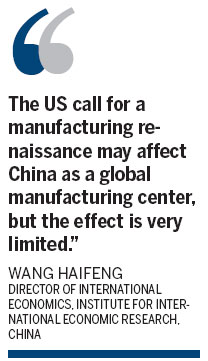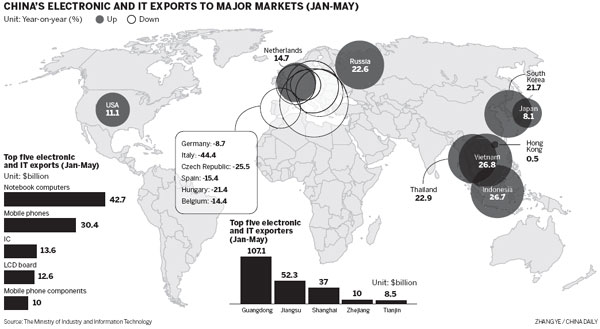Homeward bound? Firms mull return
Updated: 2012-07-23 09:28
By Shen Jingting, Chen Limin and Tuo Yannan (China Daily)
|
||||||||
BCG predicted that improved US competitiveness and rising costs in China will put the US in a strong position to add 2 to 3 million jobs in a range of industries and an estimated $100 billion in annual output by the end of the decade.
Companies in seven industries - transportation goods, appliances and electrical equipment, furniture, plastic and rubber products, machinery, fabricated metal products and computers and electronics, are most likely to be among the first to bring back production to the US, according to the BCG report.
It predicts approximately 5-15 percent of goods that the US imports from China could shift to the US before the end of the decade.
After a 35 percent decline in the number of manufacturing jobs between 1998 and 2010, an American manufacturing renaissance may help the US to restore some lost jobs. The number of manufacturing jobs will climb 3.2 percent this year compared with a 1.6 percent increase in all jobs, according to research firm IHS Global Insight.
Labor costs
The rising cost of labor in China is one of the main reasons that prompted US companies to rethink its manufacturing choices. In the BCG survey conducted in February, 92 percent of respondents said they believe that pay in China "will continue to escalate" and 70 percent agreed that "sourcing in China is more costly than it looks on paper".
Foxconn Technology Group, which manufactures Apple's iPhones and iPads, said in February that it would raise the wages of its Chinese workers by 16 to 25 percent, with monthly pay starting from 1,800 yuan ($286). It is the third pay increase by the company since 2010, when the monthly salary was 900 yuan.
According to the 2012 Asia Pacific Salary Budget Planning Survey issued by Towers Watson, a human resource consultant, respondents from China are planning to increase wages by 8.8 percent this year, while some developed markets such as Singapore and Japan are budgeting salary increases of about 3 to 5 percent.
In contrast to China, US employers are likely to cut costs - because of falling energy prices.
Analysts estimated that the US is going to benefit greatly from its rich reserves of shale gas, an alternative energy, and its early exploration work in the field, which helped the nation become the top producer globally of the resource.
An analysis by PwC consultants found that full-scale and robust shale gas development would likely have a number of knock-on effects for the manufacturing sector in the US, reducing natural gas expenses by as much as $11.6 billion annually through 2025.
William Strauss, a senior economist at the Federal Reserve Bank of Chicago, said the boom has meant US electricity prices are the lowest of any industrial nation in the world. The development could help the country lure back work sent to Asia over the years where low-cost labor has been the attraction.
Strauss said labor is still cheaper overseas but the total production costs can be higher after allowing for energy bills and the cost of shipping goods across the Pacific Ocean.
US manufacturing companies could employ approximately 1 million more workers by 2025 due to benefits from affordable energy and demand for products used to extract the gas, the PwC report said.
Costs are not the only factor in the equation. US politicians and corporate leaders have made repeated calls for the shift to inject vitality into the stagnant US economy.

 Relief reaches isolated village
Relief reaches isolated village
 Rainfall poses new threats to quake-hit region
Rainfall poses new threats to quake-hit region
 Funerals begin for Boston bombing victims
Funerals begin for Boston bombing victims
 Quake takeaway from China's Air Force
Quake takeaway from China's Air Force
 Obama celebrates young inventors at science fair
Obama celebrates young inventors at science fair
 Earth Day marked around the world
Earth Day marked around the world
 Volunteer team helping students find sense of normalcy
Volunteer team helping students find sense of normalcy
 Ethnic groups quick to join rescue efforts
Ethnic groups quick to join rescue efforts
Most Viewed
Editor's Picks

|

|

|

|

|

|
Today's Top News
Health new priority for quake zone
Xi meets US top military officer
Japan's boats driven out of Diaoyu
China mulls online shopping legislation
Bird flu death toll rises to 22
Putin appoints new ambassador to China
Japanese ships blocked from Diaoyu Islands
Inspired by Guan, more Chinese pick up golf
US Weekly

|

|








